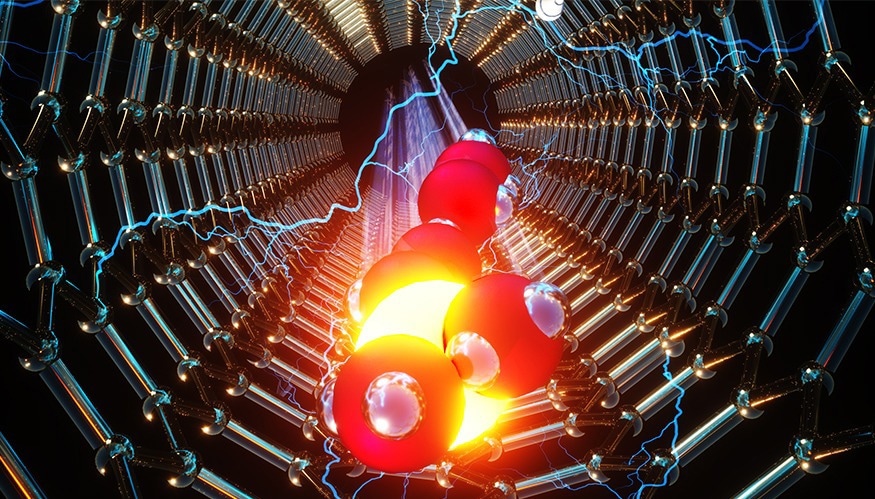To analyze particles in motion, scientists have been following a 100-year-old theory that asserts that the microscopic movement of a particle is identified by random collisions with molecules of the adjoining medium, irrespective of the macroscopic forces that influence that motion.

Artist's depiction of an ion-water cluster traveling at high speed through a carbon nanotube channel. Formation of ion-water clusters in small diameter carbon nanotubes is responsible for anomalously high electrophoretic mobility of ions inside these channels and ultimately for the strong breakdown of Nernst-Einstein relation in this system. Image Credits: Ella Maru Studio.
Scientists at Lawrence Livermore National Laboratory (LLNL) and the Massachusetts Institute of Technology have discovered that this well-known fluid dynamics relation, found by Walter Nernst and Albert Einstein at the start of the 20th century, completely breaks down in strong spatial confinement within carbon nanotube pores.
Nernst suggested a universal link between the movement of a charged particle and its diffusion coefficient in 1888. In 1905, the microscopic origins of this association were disclosed by Einstein in his annus mirabilis period, concluding with his study on Brownian motion. As it is known, the NE relation is an important building block of many essential theories of ion transport.
Confined nano- and micro-environments, like carbon nanotube porins, can verify the NE relation, as confinement can increase proximity effects, restrict ion mobility, force unusual long-range structuring of liquids, and improve particle–surface interactions—all of which affect particle motion.
The team assessed the validity of the NE relation in the new study by examining potassium (K) ion transport in 0.8-nm-diameter carbon nanotube porins (CNTPs). CNTPs are 10-nm-long segments of lipid-stabilized single-walled CNTs that, when inserted into phospholipid membranes, create well-characterized transmembrane pores that possess strong positive ion selectivity.
The extreme spatial confinement in these pores hinders the diffusion of K+ ions greatly, reducing the diffusion coefficient by three orders of magnitude relative to its bulk value. Surprisingly, the same confinement has a negligible effect on the electrophoretic mobility, leading to a complete breakdown of the NE relation.
Alex Noy, Study Co-Lead Author and Scientists, Lawrence Livermore National Laboratory
When there is no electric field, the single-file water chain with the CNTP hampered the K+ ions diffusion via the CNTP. This was shown by the molecular dynamics simulations with the use of all-atomistic polarizable force fields. In an applied electric field, however, the single-file water chain breaks down and develops discrete ion-water clusters that traverse the CNTs at much greater velocities.
These two fundamentally different microscopic mechanisms are ultimately responsible for the breakdown of the NE relation in narrow CNTPs.
David Blankschtein, Study Co-Lead Author, Massachusetts Institute of Technology
Zhongwu Li, Yuhao Li, Yun-Chiao Yao, Sidi Zhao, and Yuliang Zhang are also LLNL authors.
This study was financially supported as part of the Center for Enhanced Nanofluidic Transport (CENT), an Energy Frontier Research Center funded by the Department of Energy, Office of Science, Basic Energy Sciences.
Journal Reference
Li, Z., et al. (2022). Breakdown of the Nernst–Einstein relation in carbon nanotube porins. Nature Nanotechnology. doi.org/10.1038/s41565-022-01276-0.